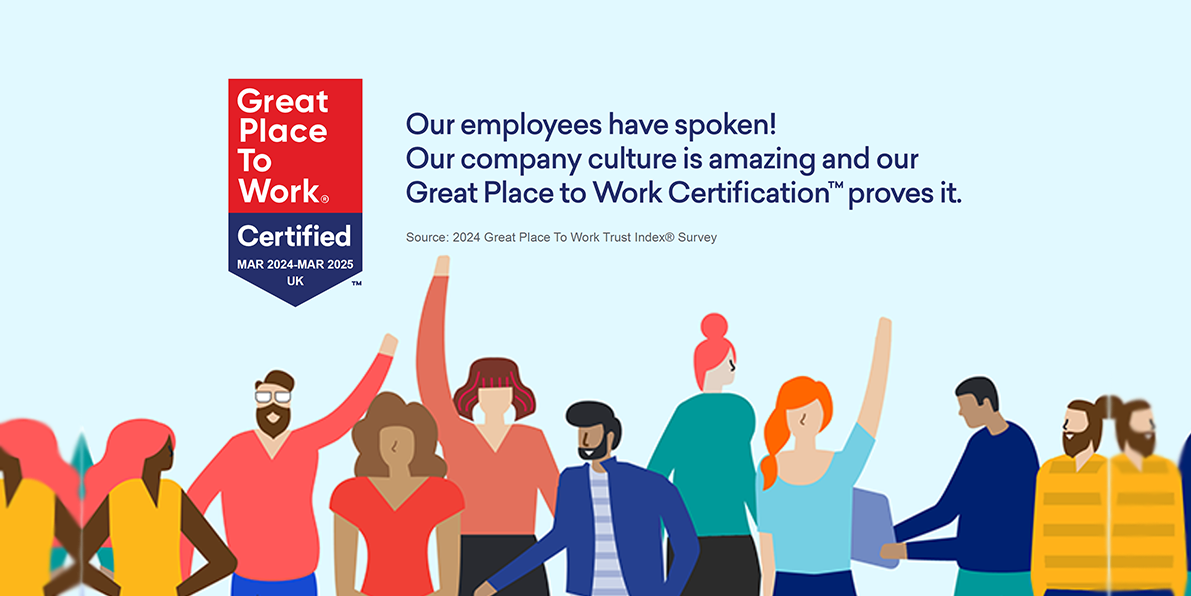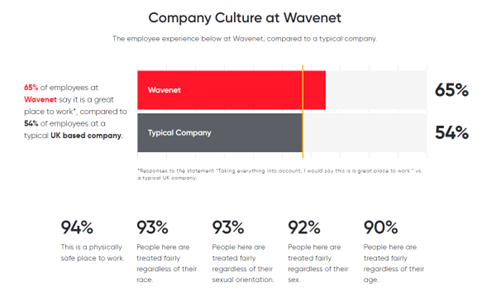Stay service-savvy
Get all the latest news and insights straight to your inbox.

The Great Place To Work (GPTW) organisation is a global authority set out to improve workplace culture within modern businesses. Their mission is to help every workplace become a better place to work fostering more spirited, successful and sustainable businesses by providing leaders the tools to enhance their overall employee experience (1). GPTW has facilitated surveys for over 100 million employees worldwide, spanning more than 18,000 companies. As a result of this they have significantly improved business cultures and working environments (2). The organisation runs on a certification basis where participating businesses can earn numerous accreditations that qualify them as great places to work.
Recently Wavenet has been granted a GPTW certification making it one of many that take part in this scheme. As a business we scored a 65% rating on the company culture questionnaire. 11% higher than the 54% average of a typical UK-based company.

There are three main steps to achieving a GPTW certification. These are:
Employers are required to select a two-week period to launch the employee survey, where colleagues are asked about certain aspects of the workplace life. The business is then required to complete a questionnaire highlighting the company’s history and overall demographic. The results of these are analysed and if an employer reached the required benchmark of 65% on the Trust Index score, then they will be certified as a GPTW. The benefits of completing this survey will allow businesses to have access to various branding and promotional materials that will aid in improving the businesses status and employee pride. Some businesses have also dramatically improved their competitiveness within their markets allowing them to stand out from the competition (3).
In order to achieve our goal of being GPTW certified we took part in various charitable events such as the London Marathon, a Sponsored Walk for Dementia UK, the Wolf Run, and much more. We also take part in various charitable schemes such as the Trussell Trust food bank collections across all our national locations helping support over 1,200 food banks across the country. Here at Wavenet we also take part in various extra-curricular activities such as The Big Goal Football tournament at St. George’s Park training ground. The Big Goal Tournament is supported by the Street Soccer Foundation who aid in vulnerable or disadvantaged young people through football. By taking part in these activities, it has allowed our colleagues to be a part of an environment that they might not have access to in other businesses. It has also aided in giving them a sense of belonging within the Wavenet community.
At Wavenet we take pride in our colleagues and we always ensure that they are always given the tools to support their wellbeing and drive our success as a business. It is crucial for us that our core values are put into practice across the business and that the culture of our business remains positive and held up to the highest standards. This is evident from our employee satisfaction survey and our new GPTW qualification.
“Obtaining our first Great Place To Work® certification reflects our dedication to creating a positive workplace culture. This accreditation highlights our commitment to employee well-being and ensures that our team members feel valued, supported, and motivated to excel.”
Alexandra Stephenson, Head of Communications.
Discover more about Wavenet's other certifications and how they drive our success here.
You can also read more on the Great Place To Work Website here: Wavenet GPTW
Featured Blog, Collaboration, Great Place To Work, Workforce engagement management
Get all the latest news and insights straight to your inbox.